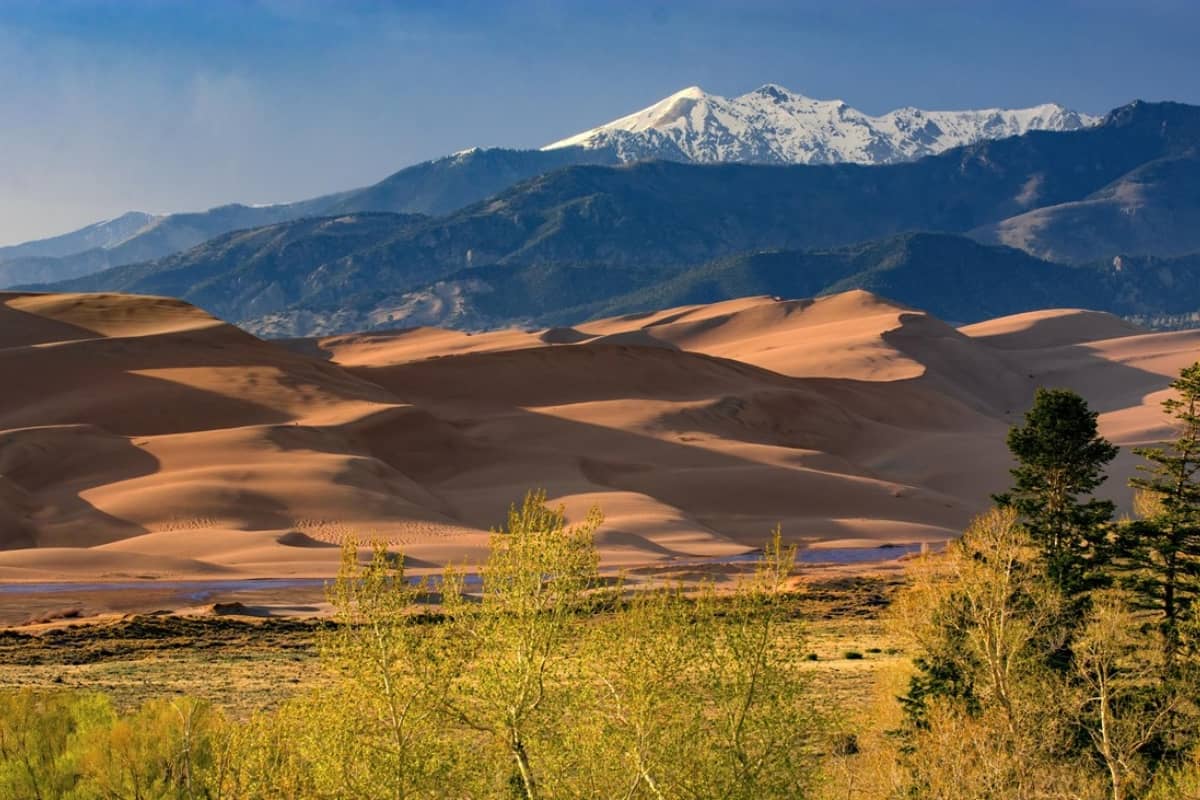Great Sand Dunes National Park and Preserve draws adventurers with its iconic sand dunes, some of which tower up to 750 feet. However, this unique landscape also hides some less obvious risks. Here’s what you need to know to stay safe and make the most of your visit.
1. Extreme Sand Temperatures: A Hidden Scorcher
Visitors to Great Sand Dunes National Park are often surprised by how quickly the sand heats up. In the peak of summer, sand temperatures can reach a scorching 150°F (65.6°C). While daytime highs might only reach around 80°F (26.7°C), the sand itself retains and intensifies the sun’s heat. This extreme heat can cause burns on unprotected skin and pose a risk for pets, as their paws can quickly blister on the hot sand.
To avoid the worst of this heat, plan your dune exploration during early mornings or late afternoons. Appropriate footwear is essential, as sandals typically offer little protection from the hot sand. Moreover, heatstroke and dehydration are real concerns in this environment, so visitors are advised to carry plenty of water and stay alert to signs of heat exhaustion.
2. High Elevation Effects: Altitude Sickness in the Making
Great Sand Dunes National Park and Preserve sits at elevations ranging from about 8,200 feet near the visitor center up to 13,604 feet in the high mountains. For those unaccustomed to high altitudes, this can lead to altitude sickness, which is marked by symptoms like headaches, nausea, dizziness, and fatigue.
Adjusting to the elevation is crucial for a safe visit. Hydration, pacing yourself, and allowing time for acclimation are essential to avoiding altitude-related complications. Limiting alcohol and caffeine intake can also help, as these substances can exacerbate dehydration. The unique challenges posed by the elevation highlight the importance of gradual adaptation to avoid potential complications.
3. Lightning Strikes: Beware the Open Expanse
Thunderstorms are common during summer afternoons in Great Sand Dunes National Park, and the vast, open landscape of the dunes leaves little protection against lightning strikes. As storms roll in, the expansive sand field becomes a magnet for lightning, posing a high risk for those out on the dunes. When lightning hits sand, it can fuse sand particles together, creating fulgurites, or “lightning rocks.” While these natural artifacts can be fascinating, the danger of lightning strikes should never be underestimated.
If you see storm clouds forming or hear thunder, the best course of action is to seek shelter in a car or head back to lower ground away from open areas. Lightning apps can be helpful for tracking nearby strikes, but remember that storms can develop quickly in this area.
4. Wildlife Encounters: Mountain Lions and Black Bears
The park is home to an array of wildlife, including mountain lions and black bears. Although sightings are rare, the presence of these large predators adds an element of caution for hikers, particularly around the edges of the dunes and near Medano Creek. Mountain lions, or cougars, are elusive and typically avoid humans, but it’s wise to remain vigilant. If encountered, make yourself appear larger by raising your arms, stay calm, and avoid turning your back. Slowly back away without running, as quick movements can trigger a chase response.
Black bears are also present in the park, though they tend to avoid the dunes and stay in the nearby forests. They can be attracted to campsites by the scent of food, so proper food storage is crucial. The park provides bear-proof containers in designated camping areas to minimize encounters. If you do encounter a bear, the general advice is to remain calm, speak softly to make it aware of your presence, and slowly retreat. Direct eye contact or sudden movements can provoke a bear, so keeping calm is key.
5. Medano Creek Hazards: Flash Floods and Currents
Medano Creek, a seasonal stream that flows around the base of the dunes, offers a refreshing break from the heat, but it’s not without its risks. The creek experiences surge flows, a unique phenomenon where underwater sand ridges build up and break, creating waves that can knock people off balance. In addition to these rapid currents, flash floods are also a possibility, particularly during heavy rain events in the spring and early summer.
During such floods, the water level can rise quickly, increasing the creek’s force and posing risks for those playing or hiking nearby. It’s essential to stay alert to weather forecasts and avoid crossing the creek if conditions appear hazardous.
6. Steep and Unstable Terrain: Hiking Challenges and Injury Risks
Hiking in the dunes is no ordinary stroll. The sand itself poses challenges, as the soft surface can make walking strenuous and exhausting. Loose sand can shift unexpectedly, particularly on steeper slopes, where hikers may lose their footing. Additionally, the lack of established trails within the dunes means there’s no set route, making it easy to get disoriented in the vast sandscape.
Falls are more common in the sand dunes than on solid ground. The steep slopes of the dunes, especially those ending near the firm sand along Medano Creek, can lead to abrupt and dangerous landings. Visitors are encouraged to use a zigzagging pattern to navigate the steep dunes safely and to avoid the highest slopes if they feel unsteady. Bringing a trekking pole or a sturdy stick can help provide additional balance.
Conclusion
Great Sand Dunes National Park and Preserve is a captivating destination that offers visitors a rare chance to experience towering sand dunes set against the stunning backdrop of the Sangre de Cristo Mountains. However, it’s essential to be aware of the hidden dangers that come with such a unique environment. Preparing for the elements, respecting wildlife, and understanding the nature of the terrain will enhance your experience and ensure a safer visit. By taking the proper precautions, you’ll be able to fully appreciate the beauty of the dunes while minimizing the risks inherent in this extraordinary landscape.






